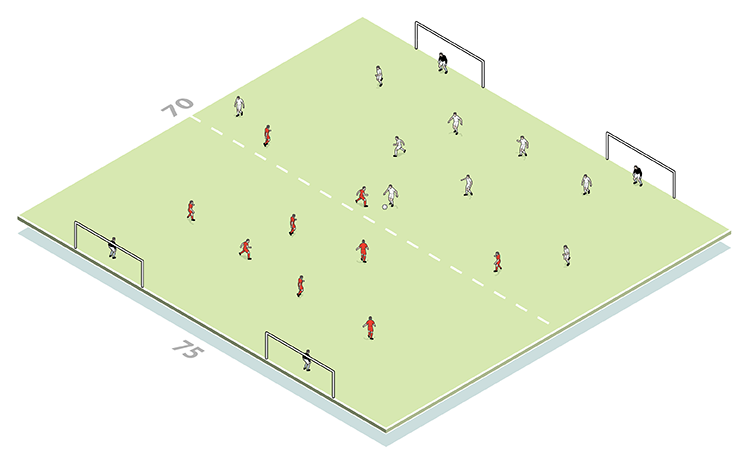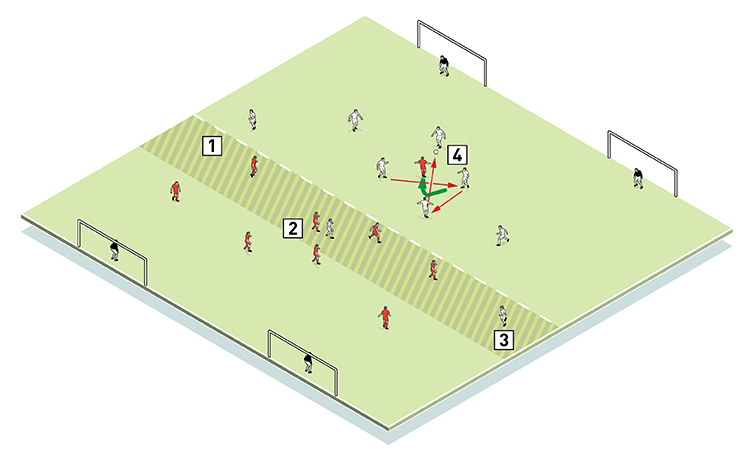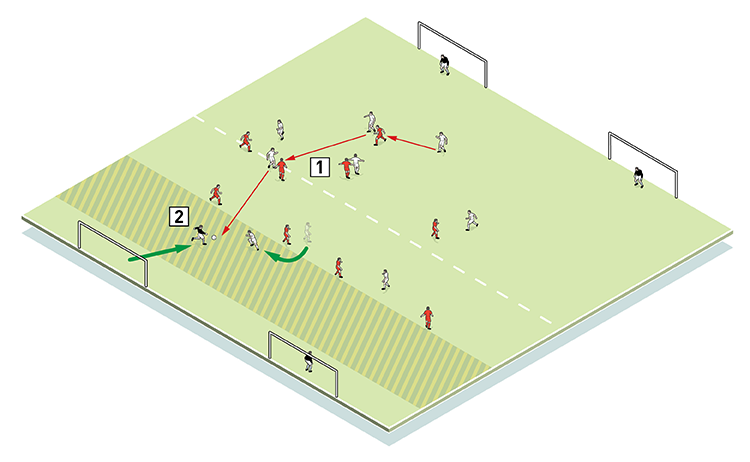You are viewing 1 of your 1 free articles
Defending shape
This is a 10v10 practice that rehearses defensive shape, both in terms of zonal marking, pressing and defending deep. It’s used to help players master the idea of getting into good shape quickly, dropping off where necessary and working as a unit to defend the goal.
| Area | 75x70 yards |
| Equipment | Balls, cones, goals |
| No. of Players | 22 |
| Session Time | 3x6min games |
This is a 10v10 practice that rehearses defensive shape, both in terms of zonal marking, pressing and defending deep. It’s used to help players master the idea of getting into good shape quickly, dropping off where necessary and working as a unit to defend the goal.
This is ideal for teams looking to practise defensive shape. They learn to understand when to press opposition, and from that, become hard to break down.
What do I get the players to do?
4-2-3 practice
Both teams, protecting two goals each, set up in a 4-2-3 formation in the area shown. This is free play to start – the challenge simply to score in either of the opposition goals.
We move the practice on by introducing an initial start position scenario. The idea of this is to pinpoint exactly what we want to coach in the most critical of scenarios.
So we’ll instruct for the ball to be given away in a specific area, when our team is now ‘out of balance’ and in poor defensive shape. If defenders cannot win the ball back immediately, they must respond as follows:
- The nearest man slows play down by going to the ball and/or screening a forward pass
- Defenders delay the play
- Team mates drop into defensive shape as quickly as possible
- Team mates stay compact and keep the ball in front of them
- Once in good defensive shape the team now looks for the right moment to press – they must look for the trigger (most often being the first person who decides to go and press the ball)
We extend the task by giving the ball away in different areas of the pitch, with different players out of position.
The intention for defenders is to always keep the play in front of them, to prevent the opposition from playing through them and to keep attackers in areas of the pitch determined by our players, not the opposition.
1

2

2. The nearest man goes to the ball, slows play down, while the rest of the team recovers defensive shape
3. The defence closes up to deny the space and the chance to play through
3

2. Communication between the two lines is vital. Midfielders and defenders must stay zonal and ‘pass-on’ opposing players as they move position
3. Defenders must have the correct body shape in staying aware of opposition players trying to overlap or penetrate defensive lines
4. The forwards still have defensive duties, but must position themselves and be ready to press
4

2. The danger of playing a high line is that defenders are open to runs and passes in behind. The keeper must concentrate, anticipate and play on the front foot, being ready to come forward and sweep up if necessary
What are the key things to look out for?
The principles of this practice include preventing the opposition players from getting in behind either from a run or a pass by denying that space. Similarly, they must prevent playing through by keeping compact. Defenders should have discipline and not be pulled out of their shape when there is no pressure on the ball.
Players must communicate with each other and recognise the ‘trigger’. When that comes, everyone must go to support and press the opposition.
When the ball is central, the back four should be ready on the half-turn to react to runners in behind. When wide, players should have an open body to see both the man and the ball. And as in any normal practice, players need to shift across the pitch quickly when play is switched, to prevent gaps opening up.
How do I progress the session?
Progressing this session is about moving to the next stage of defending - namely recognising when to go and press higher up the pitch. This may be when an opposition player makes a poor pass or touch, or when he turns to face his own goal under pressure. It might also be relevant if we’re behind late in a game, or the other team is a man down.
We then want players to know how to play the moment they win the ball back, creating space, playing quickly out, and counter-attacking.
Related Files
Editor's Picks
Intensive boxes drill with goals
Penetrating the final third
Creating and finishing
My philosophy
Pressing initiation
Compact team movement
Defensive organisation
Back three tactics
Counter-pressing as an offensive weapon
Coaches' Testimonials

Alan Pardew

Arsène Wenger

Brendan Rodgers

Carlos Carvalhal

José Mourinho

Jürgen Klopp

Pep Guardiola

Roy Hodgson

Sir Alex Ferguson

Steven Gerrard
Coaches' Testimonials

Gerald Kearney, Downtown Las Vegas Soccer Club

Paul Butler, Florida, USA

Rick Shields, Springboro, USA

Tony Green, Pierrefonds Titans, Quebec, Canada
Join the world's leading coaches and managers and discover for yourself one of the best kept secrets in coaching. No other training tool on the planet is written or read by the calibre of names you’ll find in Elite Soccer.
In a recent survey 92% of subscribers said Elite Soccer makes them more confident, 89% said it makes them a more effective coach and 91% said it makes them more inspired.
Get Monthly Inspiration
All the latest techniques and approaches
Since 2010 Elite Soccer has given subscribers exclusive insight into the training ground practices of the world’s best coaches. Published in partnership with the League Managers Association we have unparalleled access to the leading lights in the English leagues, as well as a host of international managers.
Elite Soccer exclusively features sessions written by the coaches themselves. There are no observed sessions and no sessions “in the style of”, just first-hand advice delivered direct to you from the coach.








